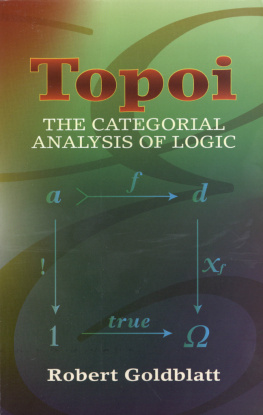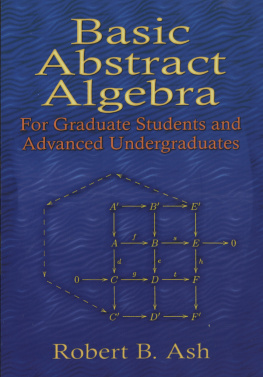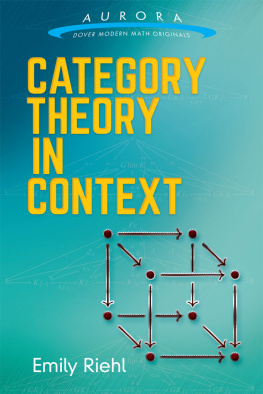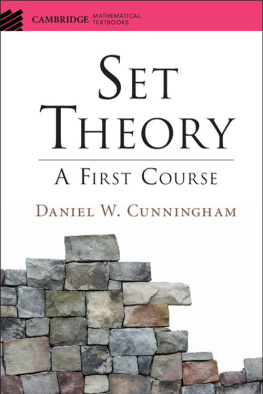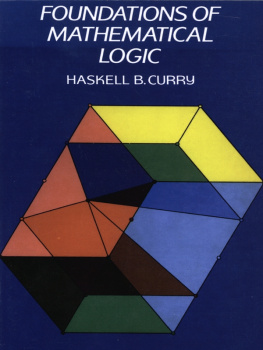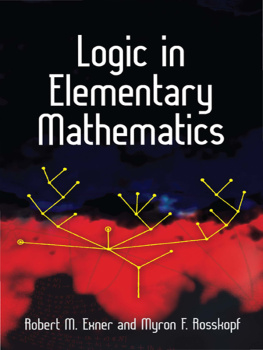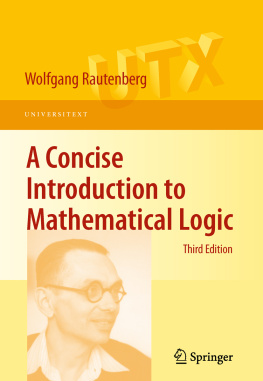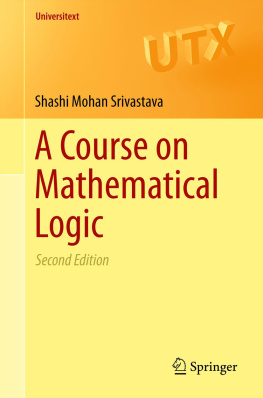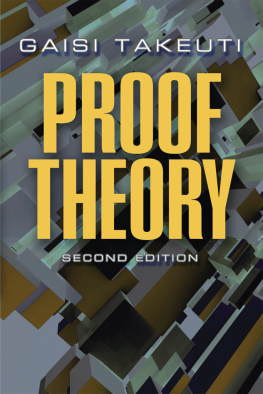T OPOI
THE CATEGORIAL
ANALYSIS OF LOGIC
T OPOI
THE CATEGORIAL
ANALYSIS OF LOGIC
REVISED EDITION
ROBERT GOLDBLATT
Victoria University
Wellington, New Zealand
DOVER PUBLICATIONS, INC.
Mineola, New York
Copyright
Copyright 1984 by Elsevier Science Publishers B.V.
New material copyright 2006 by Robert Goldblatt
All rights reserved.
Bibliographical Note
This Dover edition, first published in 2006, is a slightly corrected unabridged republication of the revised (second) edition of the work originally published in 1984 by Elsevier Science Publishers B.V., Amsterdam, The Netherlands, as Volume 98 in the North-Holland Series, Studies in Logic and the Foundations of Mathematics. A new Preface and updated Bibliography have been specially prepared for this reprint.
International Standard Book Number: 0-486-45026-0
Manufactured in the United States of America
Dover Publications, Inc., 31 East 2nd Street, Mineola, N.Y. 11501
To
My Parents
Though we may never see precisely how the protean dancing stuff of everything endlessly becomes itself, we have no choice, being human and full of desire, but to go on perpetually seeking clarity of vision. The ultimate form within forms, the final shape of change, may elude us. The pursuit of the idea of formeven the form of force, of endlessly interacting processis mans inevitable, crucial need
John Unterecker
PREFACE
No doubt there are as many reasons for writing books as there are people who write them. One function served by this particular work has been the edification of its author. Translations can sometimes create a sense of explanation, and this seemed to me particularly true of the alternative account of mathematical constructions being produced by category theory. Writing the book gave me a framework within which to confirm that impression and to work through its ramifications in some detail. At the end I knew a great deal more than when I began, so that the result is as much a recording as a reconstruction of the progress of my own understanding. And at the end it seemed to me that much that I had dwelt on had finally fallen into place.
As to the more public functions of the book I hope that it provides others with the prospect of a similar experience. Less presumptiously, I have tried to write an exposition that will be accessible to the widest possible audience of logicians the philosophically motivated as well as the mathematical. This, in part, accounts for the style that I have adopted. There is a tendency in much contemporary literature to present material in a highly systematised fashion, in which an abstract definition will typically come before the list of examples that reveals the original motivation for that definition. Paedogogically, a disadvantage of this approach is that the student is not actually shown the genesis of concepts how and why they evolved and is thereby taught nothing about the mechanisms of creative thinking. Apart from lending the topic an often illusory impression of completedness, the method also has the drawback of inflating prerequisites to understanding.
All of this seems to me particularly dangerous in the case of category theory, a discipline that has more than once been referred to as abstract nonsense. In my experience, that reaction is the result of features that are not intrinsic to the subject itself, but are due merely to the style of some of its expositors. The approach I have taken here is to try to move always from the particular to the general, following through the steps of the abstraction process until the abstract concept emerges naturally. The starting points are elementary (in the first principles sense), and at the finish it would be quite appropriate for the reader to feel that (s)he had just arrived at the subject, rather than reached the end of the story.
As to the specific treatment of category theory, I have attempted to play down the functorial perspective initially and take an elementary (in the sense of first-order) approach, using the same kind of combinatorial manipulation of algebraic structure that is employed in developing the basic theory of any of the more familiar objects of pure-mathematical study. In these terms categories as structures are no more rarified than groups, lattices, vector-spaces etc.
I should explain that whereas the bulk of the manuscript was completed around May of 1977, the , but a sufficient further preparation for the latter would be to read the first few pages of 14.1, at least as far as the introduction of the axiom COM on page 362.
A point of terminology: I have consistently used the word categorial where the literature uniformly employs categorical. The reason is that while both can serve as adjectival forms of the noun category, the second of them already has a different and long established usage in the domain of logic, one that derives from its ordinary-language meaning of absolute. Logicians have known since the work of Gdel that set theory has no categorical axiomatisation. One function of this book will be to explain to them why it does have a categorial one.
There are a number of people who I would like to thank for their help in the production of the book. I am indebted to Shelley Carlyle for her skilful typing of the manuscript; to the Internal Research Committee and the Mathematics Department of the Victoria University of Wellington for substantially subsidising its cost; to Pat Suppes for responding favourably to it, and supporting it; and to Einar Fredriksson and Thomas van den Heuvel for the expertise and cooperation with which they organised its editing and publishing.
My involvement with categorial logic gained impetus through working with Mike Brockway on his M.Sc. studies, and I have benefited from many conversations with him and access to his notes on several topics. In obtaining other unpublished material I was particularly helped by Gonzalo Reyes. Dana Scott, by his hospitality at Oxford, performed a similar service and provided a much appreciated opportunity to aquaint myself with his approach to sheaves and their logic. In preparing the material about the structure of the continuum I was greatly assisted by discussions with Scott, and also with Charles Burden.
Finally, it is a pleasure to record here my indebtedness to my teachers and colleagues in the logic group at VUW, particularly to my doctoral advisors Max Cresswell and George Hughes, and to Wilf Malcolm, for their involvement in my concerns and encouragement of my progress throughout the time that I have been a student of mathematical logic.
Where did topos theory come from? In the introduction to his recent book on the subject, Peter Johnstone describes two lines of development in the fields of algebraic geometry and category theory. It seems to me that a full historical perspective requires the teasing out of a third strand of events in the area of specific conern to this book, i.e. logic, especially model theory. We may begin this account with Cohens work in 1963 on the independence of the continuum hypothesis et. al. His forcing technique proved to be the key to the universe of classical set theory, and led to a wave of exploration of that territory. But as soon as the method had been reformulated in the ScottSolovay theory of Boolean-valued models (1965), the possibility presented itself of replacing Boolean by Heyting and thereby generalising the enterprise. Indeed Scott made this point in his 1967 lecture-notes and then took it up in his papers (1968, 1970) on the topological interpretation of intuitionistic analysis.
Meanwhile the notion of an elementary topos had independently emerged through Lawveres attempts to axiomatise the category of sets. The two developments became linked together by the concept of a
Next page
